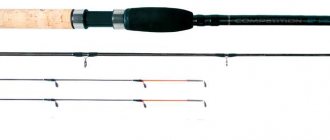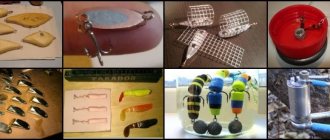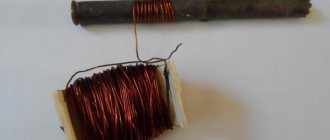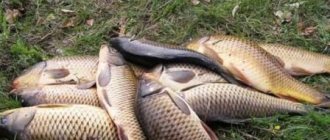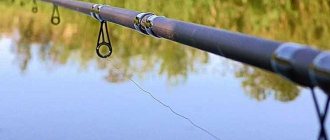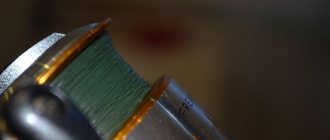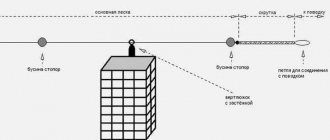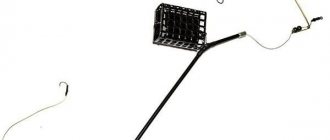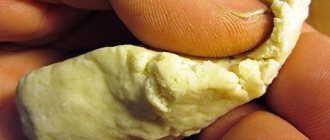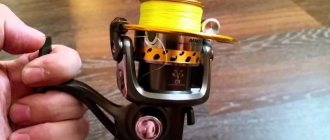Reel Maintenance
As a rule, a new spinning reel has a pleasant velvety stroke, smooth and silent rotation. But after prolonged use, some crunching, rustling and vibration appear in the mechanism. To get rid of or prevent this, it is necessary to periodically disassemble the coil, clean it of dirt and change the lubricant.
High-quality lubrication of the reel makes the operation of the reel smooth and pleasant; moreover, the new lubricant extends the service life of all mechanisms.
Maintenance of the coil should be done periodically, several times a season, depending on the frequency of use. And once a year you need to completely disassemble the coil and replace the lubricant.
Naturally, you need to constantly monitor the reel, do not drop it on hard surfaces, try to avoid water getting into the mechanism and try to avoid all kinds of contamination.
DIY coil repair
Most malfunctions of spinning reels that arise during the operation of the latter can be eliminated independently. In other cases, you still have to contact a workshop, where experienced professionals will repair any reel for a fee.
With both options, the owner will be able to not only save significant money, but also continue to use the favorite model rather than buying a new one. Before reviewing common breakdowns, it would be useful to remind you once again that the efficiency and durability of any reel largely depends on regular maintenance!
When buying a new reel, pay attention to its manufacturer; you should give preference to reels from Shimano , Daiwa and Ryobi .
Frequent coil malfunctions:
- Coil creaking
- Noise inside the coil
- The reel mechanism jams under load
- Self-resetting line handle
- Reverse stop failure
- Damage to the spool edge
- Line breaks under the clutch nut
- Spiral line feed
- Uneven line winding
- Self-tightening of the clutch
If you want to understand the topic of choosing spinning reels in more detail, we recommend our interesting review - link.
Repairing spinning reels yourself
Next, we described what exactly needs to be done with the above-described coil problems. But not all problems of spinning reels can be solved independently, because new parts may be required that can be very difficult to obtain, for example, the main pair for a specific reel.
Coil creaking
If constant squeaks occur inside the coil, it is necessary to lubricate its parts.
Of course, it is not so easy to determine which parts require lubrication, so the best option in such a situation would be to completely lubricate the entire reel mechanism.
If you have at least basic skills in disassembling, cleaning and lubricating the insides of the reel, no difficulties should arise. How to disassemble, clean and lubricate the coil, read the article - Coil Maintenance.
Damage to the reel spool
The presence of damage on the side can significantly affect the casting distance, and, naturally, only in a negative way. Also, due to scratches and unevenness of the spool, the fishing line itself often suffers, and its service life is reduced.
Therefore, after detecting such defects, hurry to eliminate them by grinding and polishing the surfaces. In some modern reels, a special coating of a hard metal alloy is applied to the side of the spool, which it is advisable to leave in place.
Important article on this topic: the best spinning reels
Reel repair by a specialist
In difficult situations, in order to repair your favorite coil model, it is better to seek help from a specialist who already has dozens of repaired and correctly configured coils behind him.
Masters who repair spinning reels have at their disposal a wide range of parts for products of any category, and therefore they will probably have something to replace the damaged element of your model.
An experienced specialist can carry out not only the repair itself, but also lubricate the parts along the way and make precise adjustments of the main pair of gears.
Care and prevention of breakdowns
The stable operation of the coils and their service life largely depend on the handling of the product. Careful transportation of the coils and careful care will certainly extend their life. Avoid dropping and hitting the reel, try to immerse it in water as little as possible, and do not put the reel in sand.
Cleaning the reel
Sand getting inside the housing leads to rapid wear of parts, primarily the main pair of gears. In this regard, it is necessary to periodically disassemble and clean the coil.
We wrote a very useful article in which we described in detail the process of disassembling, cleaning, lubricating and assembling the reel. In the article you will learn about the internal structure of reels, types of lubricants and other valuable tips. Read about it at the link here - disassembling and lubricating coils.
Coil lubrication
Another reason for coil breakdowns is the lack of lubrication of the internal mechanisms. After each cleaning of sand and dirt, the parts must be lubricated. The oil used for this purpose should not be too thick, without various additives that can damage plastic parts. Naturally, it is better to buy special oil designed specifically for lubricating coils.
Careful operation and periodic maintenance will extend the life of the reel and protect it from damage. If the latter do arise, you need to promptly take care of repairs at an early stage, so that a minor problem does not turn into a large or even critical one.
Ivanov Vitaly Leonidovich, 2021.
| Spinning rod rigs (Texas, Carolina, dropshot) | Fishing knots and leashes, knot strength | How to disassemble and lubricate the reel |
| Fishing with jerkbaits | Fishing with surface baits (gliders) | Propbait fishing (lure with a propeller) |
| How to choose a popper, what to look for when choosing | Devon fishing (unique spinner with a propeller) | Do-it-yourself spinnerbait (making and fishing) |
| DIY fishing craftsDo it yourself16 thousand views |
| winter spinners for perch fishingWinter fishing13 thousand views |
| Review of the best balancers for winter fishingWinter fishing1454 views |
| Fishing with jigs: varieties, gear, fishing techniquesWinter fishing19 thousand views |
| Types of fish finder echo sounders for fishing Echo sounders19 thousand views |
| Review of aluminum boats for fishingBoats14 thousand views |
| Review and rating of echo sounders for fishingEcho sounders7 thousand views |
| How to choose a spinning reel? Reels10 thousand views |
| Electric motors for inflatable boats (review)Motors3 thousand views |
| Aluminum fishing boatsBoats8 thousand views |
| Which coil to choose for a feeder - review of characteristicsFeeder19 thousand views |
| Characteristics and capabilities of feeder rodsFeeder6 thousand views |
| carp reels with baitrunnerCarpfishing9 thousand views |
| Fishing boat: what to look for when purchasing Boats21 thousand views |
| How to choose a motor for a boat?Motors3 thousand views |
| Classification of wobblers and other baitsSpinning30 thousand views |
| Fishing with silicone baitsSpinning15 thousand views |
| The best wobblers for pike: size, color, spinning rod4 thousand views |
| Fishing with a feeder on flat feedersFeeder8 thousand views |
| Homemade bait for bream with your own handsFeeder21 thousand views |
| Spinning fishing with rattlinsSpinning3 thousand views |
| How to choose a carp reel: review and ratingCarpfishing14 thousand views |
Source: https://fisher-book.ru/441-remont-katushki-svoimi-rukami
How to disassemble a spinning reel
When disassembling a spinning reel, lay out all its parts in order from right to left, this will allow you to quickly and correctly assemble the reel.

Carefully remember the position and installation order of all parts, follow the following instructions.
Reel disassembly steps:
- Remove the friction brake nut;
- Remove the spool;
- Remove the washers and gears on the rod;
- Unscrew the handle;
- We disassemble the coil mechanism: unscrew the bolt securing the nut.
- Carefully unscrew the rotor clamping nut with a wrench or pliers;
- Removing the rotor
- We remove the line-laying arm and the mechanism that locks it from the rotor.
- We disassemble the line roller (unscrew it with a screwdriver);
- Unscrew the bolts and plugs on the cover and remove the cover.
- Inside the coil you will see two gears and a slider - this is the main mechanism.
- Next, you need to remove the rod, after unscrewing the bolt that secures it.
- Remove the main gear, small gear and other parts.
- To remove the pinion gear, unscrew the three bolts.
- Remove the bearing from the pinion gear.
- Remove the cylinder from the pinion gear.
Reel disassembly is complete!
See video below for disassembly and assembly.
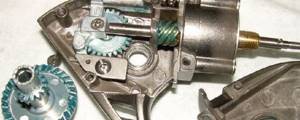
Reassembling the coil is carried out in the reverse order.
Disassembling the main reel mechanism
Now we move on to the most difficult step compared to the previous ones, disassembling the mechanism for rotating the reel and controlling the stroke of the spool. I think you can remove the spool and unscrew the handle without a detailed description.
This mechanism is disassembled to lubricate parts or replace any parts, if you have any.
Let me make a reservation right away, do you see this pin?
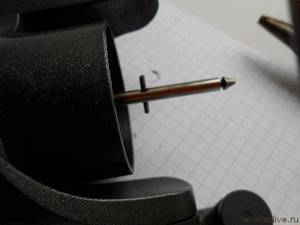
There is no need to try to pull it out, you don’t need it, it is pressed in, and after pulling it out once, it will constantly rattle and fall out at the most inopportune moment.
Unscrew the mechanism cover. It is held on by three screws; after unscrewing them, pry the cover with a flat-head screwdriver and remove it:
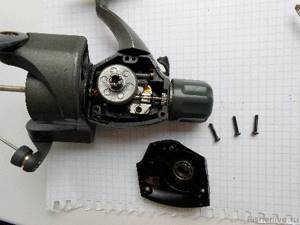
Now lift up the main gear, and slightly tilt it down the coil:
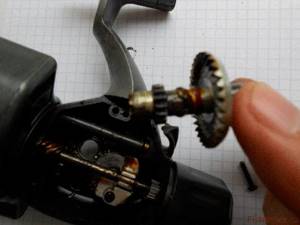
Now unscrew this screw:
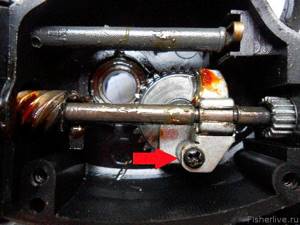
By the way, this photo clearly shows where to lubricate the reel mechanisms.
Spinning reel lubrication
- Clean the surface of the coil.
- Disassemble the coil.
- Clean parts in gasoline.
- Lubricate parts and bearings.
- Assembling the reel.
Grease is used to lubricate gears and parts. Liquid lubricant is used to lubricate the bearings.
The teeth of all gears must be lubricated so that the grease completely fills the space between the teeth. Excess grease must be removed. Grease the large gear, the pinion gear, the small gear, the internal part on the small gear, and the rod.
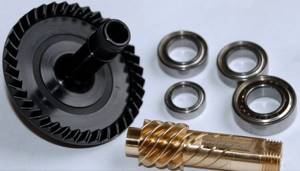
A thin layer of thick lubricant can be used to coat other metal parts to prevent them from corroding. Open type bearings are lubricated with liquid lubricant, while closed type bearings do not need to be lubricated.
During assembly, the pin of the small gear should fit into the groove of the part covering it. The main gear needs to be lubricated in several places and installed in the reel body. Next, lubricate the rod along its entire length with thick lubricant and install it in place. The main reel mechanism is lubricated!
Reassembling the coil is carried out strictly in reverse order!
How to wind fishing line
The cord is wound onto the spool of the mechanism after the reel is secured to the spinning rod. This operation can be done independently, or with the help of a friend, which greatly simplifies the process and does not require additional actions or the use of devices. Initially, the spinning rod is assembled along the entire length of the rod and starting from the tulip, the very first ring on the quiver tip of the tackle, the cord is passed all the way to the spool. The cord is attached to the spool using the technique of tying a self-tightening knot. Having tied a knot and tightened it at the base of the spool, the tip of the free fishing line is cut off to a residue of no more than 2 mm, since a longer tail can interfere with the release of the thread during casting, slowing down its release. Next, wind the thread. In this case, the cord must be in constant tension.
Reel Lubricant
Do not use grease as a thick lubricant.
Use specialized thick and liquid lubricants for reels. On sale you can find lubricants for reels from specialized fishing companies: Abu Garcia, Daiwa, Shimano, Ryobi, Tica, Mikado, SFT, etc.
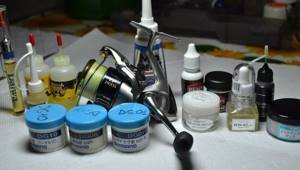
It is better to use lubricant from the same company that manufactured the reel.
For example, Shimano produces a special grease designed for the main pair, mechanisms and bearings. Its viscous structure reduces friction, increases reel life and makes reel operation smoother.
The price of reel lubricants ranges from $2 to $100, depending on the brand and volume.
Disassembling the line guide bracket mechanism
This unit is the most important in the reel, and requires constant lubrication, since this is where most of the moisture gets. In this article, we will not consider removing the entire bracket and removing the roller, since the roller can be lubricated without disassembly with ordinary silicone grease, then wipe the working surface with a napkin, and the entire bracket can be removed quite rarely.
Unscrew the mechanism cover bolt:
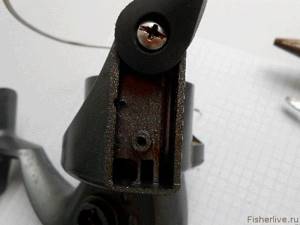
There should be a spring here, but I don’t have one because it’s broken. To prevent this from happening to you, lubricate this unit regularly. Weakening or breaking of the spring will result in the bracket not closing completely, the fishing line will not slide onto the roller, and will eventually get twisted.
Next, unscrew the bolt of the bracket holder itself and remove the bracket to the side:
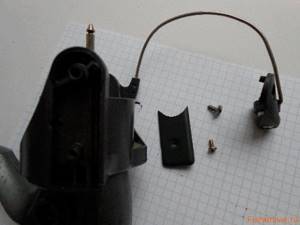
From here we can remove the spring (which I don’t have) to stretch it a little and a small wire that serves to snap the bracket in place if you suddenly forgot to close it and started to rotate the reel handle:

By the way: I do not recommend using this mechanism; it is better to close the bracket yourself, as this mechanism severely damages the parts of the reel and shortens its service life.
